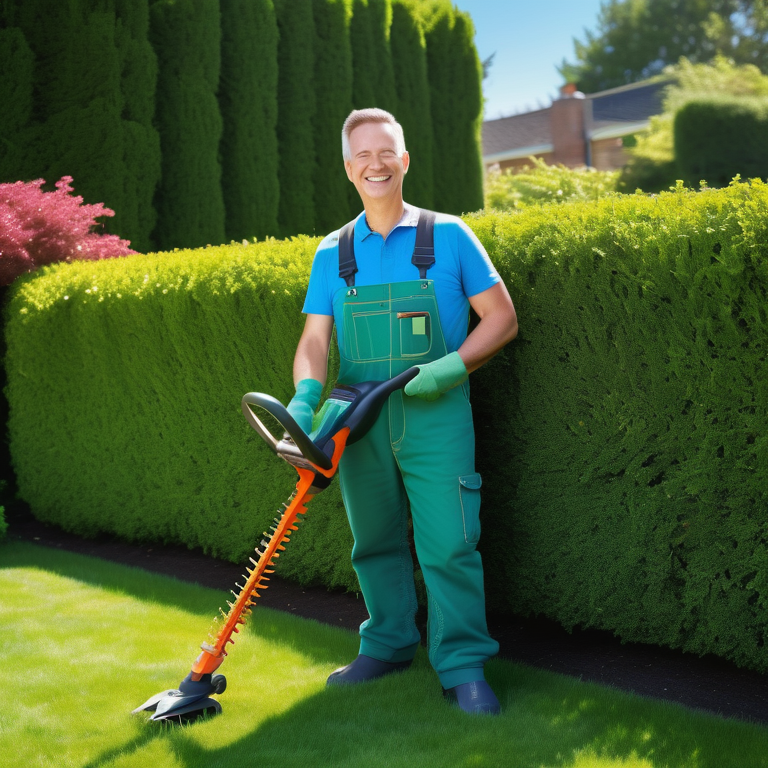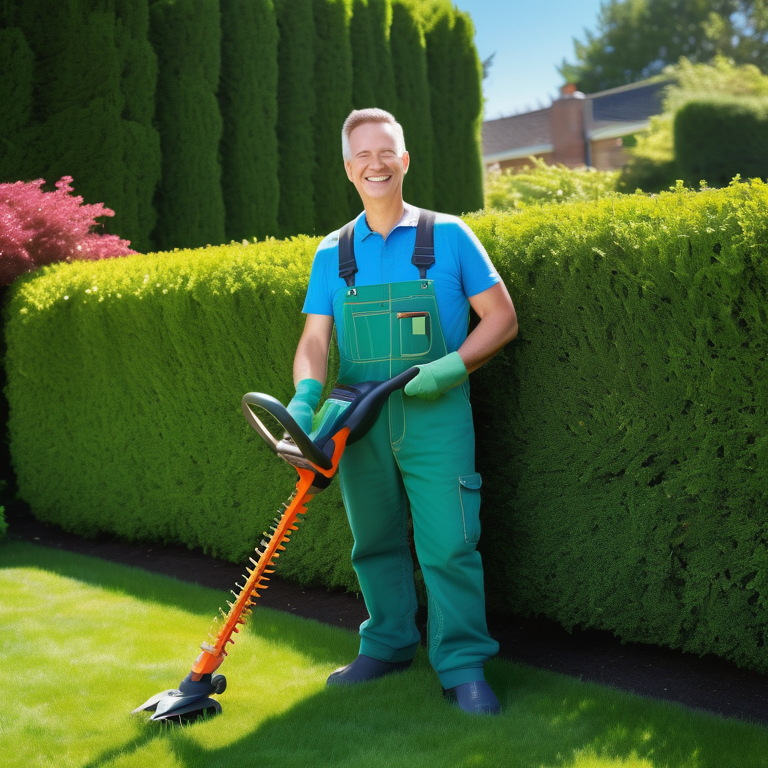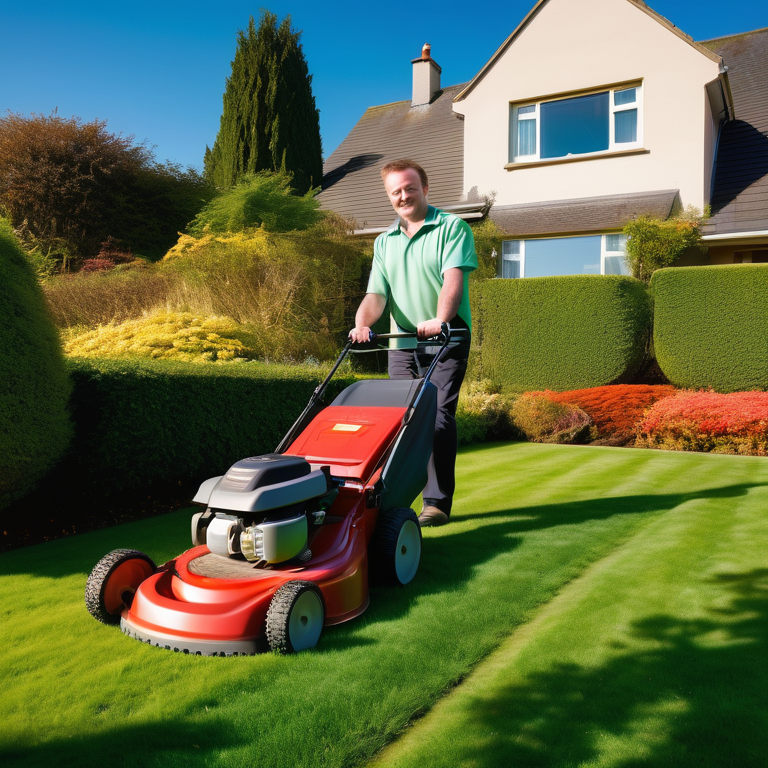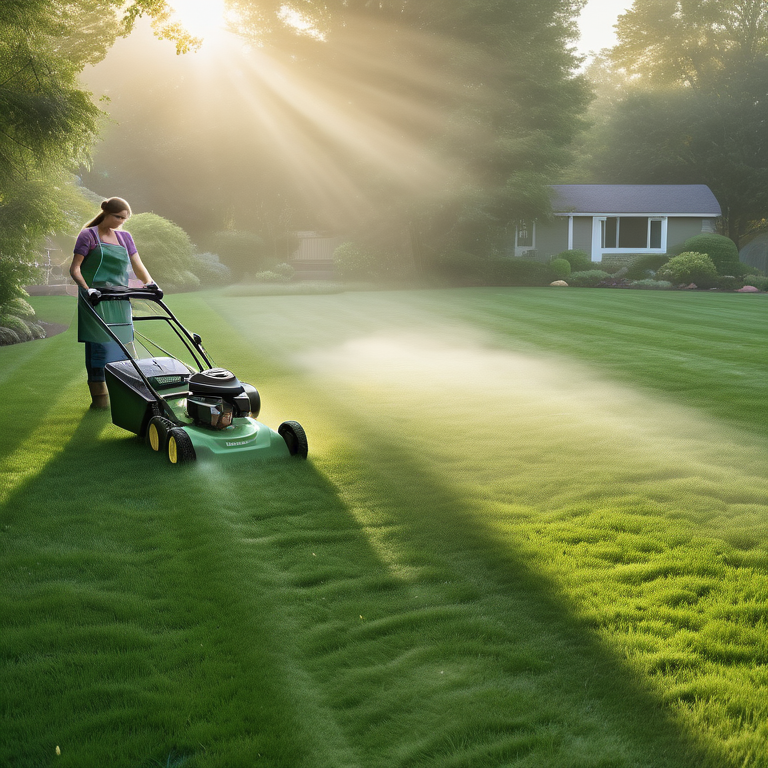Key Highlights
- Regular trimming is essential for maintaining the size and density of hedges- Different types of hedges require different care maintenance.
- Proper preparation and the right equipment are crucial for trimming large hedges.
- Assessing the health and shape of hedges is important before trimming.
- Timing is key – late winter or early spring are the seasons for trimming.
- Advanced techniques like shaping and managing overgrown hedges can yield impressive results.
Introduction
Trimming large hedges can be a daunting task, but with the right knowledge and techniques, you can achieve professional results. Regular maintenance is crucial for keeping hedges looking neat and healthy. In this blog, we will guide you through the process of trimming large hedges, from understanding the importance of regular maintenance to advanced trimming techniques. We will also provide tips on preparation, the right tools to use, and aftercare and maintenance. Whether you have formal hedges, informal hedges, or conifer hedges, this blog will equip you with the necessary knowledge to prune like a pro.
Understanding Hedge Trimming
Hedge trimming is the process of cutting back and shaping hedges to maintain their size, density, and appearance. Regular trimming is essential to prevent hedges from becoming overgrown and unruly. By removing excess foliage, regular trimming allows for new growth and helps hedges maintain their desired shape.
Different types of hedges require different care and maintenance. Formal hedges, such as those made from privet or boxwood, are often trimmed to a squared or wedge shape with the base wider than the top. This allows maximum light to reach the base and creates a more solid appearance. Informal hedges, on the other hand, are usually cut back after flowering to maintain a more relaxed and natural look. Conifer hedges, like leylandii or yew, require regular trimming to prevent them from becoming too large and unmanageable.
The Importance of Regular Maintenance
Regular maintenance is crucial for keeping hedges healthy and attractive. Trimming hedges on a regular basis helps to control their size and shape. By removing excess foliage, hedges can maintain a neat and tidy appearance. Regular maintenance also encourages new growth and ensures that hedges stay dense and full.
Without regular trimming, hedges can become overgrown, losing their shape and becoming difficult to manage. Overgrown hedges can also create a barrier for natural light, resulting in less growth and potentially unhealthy plants. By trimming hedges on a regular basis, you can ensure that they stay in optimal condition and continue to enhance the beauty of your outdoor space. www.wicklowlandscaping.ie
Different Types of Hedges and Their Care
Different types of hedges require different care and maintenance. Formal hedges, such as those made from privet or boxwood, are often used to create a structured and formal look in gardens. These hedges are typically trimmed regularly to maintain a squared or wedge shape with a wider base and a narrower top. This allows maximum light to reach the base and creates a solid appearance.
Informal hedges, on the other hand, are typically made from larger-leaved deciduous plants such as forsythia or berberis. These hedges are often cut back after flowering to maintain a more relaxed and natural look. Native plants like hawthorn or blackthorn are great choices for informal hedges, as they provide habitat and food for wildlife.
Conifer hedges, like leylandii or yew, require regular trimming to prevent them from becoming too large and unmanageable. These hedges should not be cut back beyond the green growth, as they will not regenerate from older wood. It’s important to assess the type of hedge you have and understand its specific care requirements before trimming. www.wicklowlandscaping.ie
Preparing to Trim Large Hedges
Before trimming large hedges, it’s important to properly prepare to ensure a successful and safe trimming process. Large hedges may require more time and effort compared to smaller hedges, so it’s essential to have the right equipment and safety gear.
One of the key considerations when trimming large hedges is choosing the right tools. Manual hedge trimmers are suitable for smaller hedges, but for larger hedges, powered hedge trimmers are more efficient. Electric hedge trimmers are a popular choice as they are lightweight and easy to maneuver. Petrol trimmers offer more power and are suitable for trimming larger hedges. It’s important to choose a trimmer with the maximum power suitable for your specific hedge size.
In addition to the right tools, safety gear is essential when trimming large hedges. Safety goggles should be worn to protect your eyes from flying debris. It’s also important to wear protective clothing, such as long sleeves and pants, to protect your skin from scratches and cuts. Using a residual current device (RCD) with electric trimmers is recommended to ensure electrical safety. www.wicklowlandscaping.ie
Essential Tools for Effective Trimming
Choosing the right tools is crucial for effective trimming of large hedges. Manual hedge trimmers are suitable for smaller hedges and offer more control, but for large hedges, powered hedge trimmers are recommended.
Electric hedge trimmers are a popular choice for trimming large hedges. They are lightweight and easy to maneuver, making the trimming process more efficient. Electric trimmers also eliminate the need for fuel and produce less noise compared to petrol trimmers.
Petrol trimmers, on the other hand, offer more power and are suitable for trimming larger hedges. They are not limited by cords, allowing for greater mobility. Petrol trimmers are generally heavier than electric trimmers and can produce more noise and emissions.
When choosing a hedge trimmer, it’s important to consider the size and type of hedge you have. Electric trimmers are suitable for most large hedges, but if you have particularly large or dense hedges, a petrol trimmer may be more efficient. It’s also important to consider your own strength and comfort when choosing a trimmer, as some models may be heavier or more difficult to handle. www.wicklowlandscaping.ie
Safety Gear and Precautions
When trimming large hedges, safety should be a top priority. It’s important to wear the appropriate safety gear and take necessary precautions to avoid injuries.
Safety goggles should be worn to protect your eyes from flying debris while trimming. Protective clothing, such as long sleeves and pants, can help prevent scratches and cuts from branches and thorns. Gloves are also recommended to provide a better grip and protect your hands.
Using a residual current device (RCD) when using electric trimmers is essential for electrical safety. An RCD is a safety device that detects electrical faults and quickly shuts off power to prevent electric shocks. It’s important to ensure that the RCD is working properly before starting the trimming process.
Before trimming, it’s also important to remove any obstacles or debris from the area around the hedge. This will help prevent tripping hazards and ensure a safe working environment. It’s also a good idea to have a first aid kit nearby in case of any minor injuries.
By following these safety precautions and wearing the appropriate safety gear, you can ensure a safe trimming process and avoid accidents or injuries. www.wicklowlandscaping.ie
Step-by-Step Guide to Trimming Large Hedges
Trimming large hedges requires a systematic approach to achieve the best results. Here is a step-by-step guide to trimming large hedges:
- Assess Your Hedge’s Health and Shape: Before starting the trimming process, assess the health and shape of your hedge. Look for any signs of disease or pest infestation and determine the desired height and shape for your hedge.
- Timing: The Best Seasons for Trimming: Timing is crucial when it comes to trimming large hedges. Late winter or early spring, before the growing season begins, is generally the best time to trim hedges. This allows for new growth to emerge and recover before the next year’s growth cycle.
- Techniques for a Clean Cut: To achieve a clean cut, start by trimming the side of the hedge. Keep the blades parallel to the side of the hedge and trim in smooth, continuous swathes. Work from the bottom of each side and work upwards, tapering the hedge slightly narrower at the top.
- Trim the Top of the Hedge: Once the sides are trimmed, move on to the top of the hedge. Use a string line or a guide to ensure a straight top. Trim the top of the hedge, leaving about 1cm (½in) of new growth to maintain the desired height.
- Clear Away Clippings: After trimming, it’s important to clear away the clippings. Rake or sweep the clippings off the top of the hedge to allow light to reach the cut stems and encourage regrowth. Dispose of the clippings in a compost bin or green waste recycling bin.
By following these steps and taking your time, you can achieve a neatly trimmed hedge that enhances the beauty of your outdoor space. www.wicklowlandscaping.ie
Assessing Your Hedge’s Health and Shape
Before trimming your large hedge, it’s important to assess its health and shape. Look for any signs of disease or pest infestation, such as yellowing leaves or evidence of pests. If you notice any issues, it’s important to address them before trimming.
Additionally, determine the desired height and shape for your hedge. Consider the overall aesthetic you want to achieve and the specific requirements of your hedge type. A straight edge can create a formal and neat appearance, while a more natural and relaxed look may be desired for informal hedges. Taking the time to assess your hedge’s health and shape will ensure that you trim it to your desired specifications.
Timing: The Best Seasons for Trimming
Timing is crucial when it comes to trimming large hedges. Late winter or early spring, before the growing season begins, is generally the best time to trim hedges. This allows for new growth to emerge and recover before the next year’s growth cycle.
However, it’s important to consider the specific needs of your hedge type and the local climate. Some hedges may benefit from a late summer or early autumn trim to promote healthier growth. Additionally, if nesting birds are present in your hedge, it’s important to delay trimming until they have finished nesting. The Countryside Act of 1981 makes it illegal to knowingly damage an active bird’s nest, so it’s important to be aware of nesting seasons and legal restrictions before trimming.
By trimming your hedges at the right time, you can promote healthy growth and maintain the desired shape and size of your hedge. www.wicklowlandscaping.ie
Techniques for a Clean Cut
Achieving a clean cut is essential for maintaining the health and appearance of your hedge. Start by trimming the side of the hedge, keeping the blades parallel to the side and working from the bottom up. This will ensure a smooth and even cut.
Formative pruning is a technique that involves shaping and training young hedges to achieve the desired form. By removing excess growth and shaping the hedge early on, you can establish a well-structured hedge.
For thicker branches or a more natural look, use secateurs or loppers to selectively remove older branches. This will help maintain a clean and tidy appearance while allowing the hedge to retain its natural shape.
By using these techniques, you can achieve a clean and professional-looking cut for your large hedges. www.wicklowlandscaping.ie
Advanced Hedge Trimming Techniques
Once you have mastered the basics of hedge trimming, you may want to explore advanced techniques to further enhance the appearance of your large hedges. Here are some advanced hedge trimming techniques:
- Shaping and Styling Your Hedge: If you are looking to create a more formal or decorative look, consider shaping and styling your hedge. This can include creating geometric shapes, such as squares or cones, or more intricate topiary designs. Use string lines or templates to guide your trimming and create precise shapes.
- Managing Overgrown Hedges: If your hedge has become overgrown and unruly, you may need to employ more drastic measures to restore its shape. Start by removing larger branches that are obstructing the overall form of the hedge. Then, gradually trim back the remaining growth to the desired shape. This process may take multiple trimming sessions over the course of several years.
It’s important to exercise caution when dealing with larger branches. Use loppers or a pruning saw to safely remove branches that are more than 1cm in diameter. Take your time and work systematically to ensure a clean and even cut.
By mastering these advanced techniques, you can transform your large hedges into stunning focal points in your outdoor space.
Shaping and Styling Your Hedge
If you are looking to add a touch of artistry to your large hedges, shaping and styling can make a dramatic impact. Shaping involves trimming the hedge to create geometric shapes or precise forms. This can include squares,, cones, or spirals. String lines or templates can be used to guide the trimming process and ensure precise shapes.
Topiary is a more intricate form of shaping that involves creating unique and elaborate designs from living plants. This art form allows you to shape hedges into animals, letters, or other creative forms. Topiary requires patience and careful trimming to maintain the desired shape over time.
Shaping and styling your hedges can add a unique and decorative element to your outdoor space. It’s important to remember that these techniques require regular maintenance and trimming to preserve the desired shape. www.wicklowlandscaping.ie
Managing Overgrown Hedges
Over time, hedges can become overgrown and lose their shape. Managing overgrown hedges requires a careful and systematic approach to restore their form and promote healthy growth.
Start by removing larger branches that are obstructing the overall shape of the hedge. This will allow you to assess the remaining growth and determine the best course of action. Gradually trim back the remaining growth, focusing on shaping the hedge to your desired specifications.
When managing overgrown hedges, it’s important to strike a balance between restoring the shape and preserving a more natural look. Avoid severe pruning that may shock the plant and lead to poor regrowth. Instead, aim for a gradual and controlled approach to manage the growth of the hedge.
By managing overgrown hedges effectively, you can restore their beauty and ensure they continue to enhance your outdoor space.
Aftercare and Maintenance
After trimming your large hedges, it’s important to provide proper aftercare and maintenance to ensure their health and continued growth. Here are some key steps to take:
- Fertilizing and Watering Post-Trim: After trimming, hedges may benefit from a boost of nutrients to support new growth. Apply a balanced fertilizer around the base of the hedge and water thoroughly to promote healthy regrowth.
- Pest Control and Disease Prevention: Monitor your hedges for signs of pests or disease and take appropriate measures to control and prevent them. Regularly inspect the foliage for any signs of infestation or damage and consult with a professional if necessary.
- Regular Trimming: To maintain the size and shape of your hedges, continue with regular trimming. Trimming on a regular basis will prevent overgrowth and help keep the hedges looking neat and tidy. Be sure to follow the appropriate timing and techniques for trimming based on the specific type of hedge you have.
By providing proper aftercare and regular maintenance, you can ensure that your large hedges remain healthy and vibrant for years to come. www.wicklowlandscaping.ie
Fertilizing and Watering Post-Trim
After trimming your large hedges, it’s important to provide them with the necessary nutrients and water to support new growth. Fertilizing and watering post-trim can help promote healthy regrowth and maintain the health of your hedges.
Apply a balanced fertilizer around the base of the hedge, following the manufacturer’s instructions. This will provide the necessary nutrients for new growth and help the hedge recover from the trimming process. Water the hedge thoroughly after applying the fertilizer to ensure the nutrients are absorbed by the roots.
In addition to fertilizing, regular watering is important to maintain the health of your hedges. Water the hedge deeply, allowing the water to penetrate the root zone. This will help promote healthy growth and prevent the hedge from drying out.
By providing the necessary nutrients and water, you can ensure that your hedges remain healthy and vibrant after trimming.
Pest Control and Disease Prevention
To maintain the health of your large hedges, it’s important to take measures to control pests and prevent diseases. Regular monitoring and appropriate action can help keep your hedges thriving.
Inspect the foliage of your hedges regularly for signs of pests, such as aphids or scale insects. If you notice any infestations, treat them promptly with appropriate methods, such as insecticidal soap or horticultural oil. Consult with a professional if the infestation is severe or persistent.
Disease prevention is also key to maintaining a healthy hedge. Proper pruning techniques, such as clean cuts and disinfecting tools, can help prevent the spread of diseases. Remove any diseased or infected branches promptly to prevent further damage.
By practicing pest control and disease prevention, you can ensure that your large hedges remain healthy and free from infestations or diseases. www.wicklowlandscaping.ie
Common Mistakes and How to Avoid Them
While trimming large hedges, it’s important to be aware of common mistakes to avoid. By understanding these mistakes and taking appropriate precautions, can achieve better results and maintain the health of your hedges.
- Over-trimming: One of the most common mistakes is over-trimming. It’s important to avoid removing too much foliage, as this can weaken the hedge and inhibit its growth. Instead, trim the hedge gradually and follow the specific trimming guidelines for your hedge type.
- Ignoring Weather Conditions: Trimming hedges in wet or frosty conditions can lead to damage and poor regrowth. It’s important to wait for dry weather and avoid trimming during freezing temperatures. This will prevent the hedge from becoming stressed and promote healthy growth.
- Improper Timing: Trimming hedges at the wrong time of year can also be a mistake. Each hedge type has specific timing requirements, so it’s important to research and follow the appropriate trimming schedule. Trimming at the wrong time may result in poor regrowth or damage to the hedge.
By avoiding these common mistakes and following proper trimming techniques, you can achieve better results and maintain the health of your large hedges. www.wicklowlandscaping.ie
Over-trimming and Its Consequences
Over-trimming, or removing too much foliage, can have negative consequences for your hedges. It’s important to avoid this common mistake to maintain the health and appearance of your hedges.
When hedges are over-trimmed, they may become weak and struggle to regrow. Removing too much foliage can inhibit the hedge’s ability to photosynthesize and produce energy. This can result in sparse growth and a less vibrant appearance.
To avoid over-trimming, it’s important to follow the specific trimming guidelines for your hedge type and trim gradually. By trimming in moderation and allowing the hedge to recover between trimming sessions, you can maintain a healthy and lush hedge. www.wicklowlandscaping.ie
Ignoring Weather Conditions
Trimming hedges in unfavorable weather conditions can have detrimental effects on their health and growth. Ignoring weather conditions is a common mistake that should be avoided.
Trimming hedges during wet or frosty conditions can cause damage and inhibit regrowth. Wet conditions can make the hedge vulnerable to diseases, while frost can damage the plant tissue. It’s important to wait for dry weather and avoid trimming during freezing temperatures.
Timing is key when it comes to trimming hedges. Each hedge type has specific timing requirements, so it’s important to research and follow the appropriate schedule. Trimming at the wrong time may result in poor regrowth or damage to the hedge.
By paying attention to weather conditions and trimming at the right time, you can ensure the health and vitality of your hedges.
Key Takeaways on Trimming Large Hedges
- Regular trimming is essential for maintaining the size and density of hedges.
- Different types of hedges require different care and maintenance.
- Proper preparation and the right equipment are crucial for trimming large hedges.
- Assess the health and shape of your hedge before trimming.
- Timing is key – late winter or early spring are the best seasons for trimming.
- Advanced techniques like shaping and managing overgrown hedges can yield impressive results.
Clearly Describe the Topic & Focus
The topic of this blog is trimming large hedges, with a focus on providing comprehensive information and techniques to achieve professional results. The key takeaways from this blog include the importance of regular trimming, different types of hedges and their care, the right tools and safety gear for trimming large hedges, a step-by-step guide to trimming, advanced techniques for shaping and styling hedges, aftercare and maintenance tips, and common mistakes to avoid. By following the information and techniques presented in this blog, readers will have the knowledge and confidence to trim large hedges effectively and maintain their health and appearance. www.wicklowlandscaping.ie
Summarize State of Knowledge: Knowns and Unknowns
The state of knowledge regarding trimming large hedges is well-established. It is known that regular trimming is essential for maintaining the size and density of hedges, and different types of hedges require different care and maintenance. The importance of proper preparation, the right tools and safety gear, and assessing the health and shape of hedges before trimming is also well-established. There is a wealth of information available on the techniques and timing for trimming hedges. However, there may be unknowns regarding specific hedge types or unique trimming challenges that require further research or professional advice. Overall, the knowledge and techniques presented in this blog provide a solid foundation for successfully trimming large hedges. www.wicklowlandscaping.ie
Blog’s Main Argument and Insights
The main argument of this blog is that with the right knowledge and techniques, homeowners can effectively trim large hedges like professionals. By understanding the importance of regular maintenance, different types of hedges and their care, and the proper tools and safety precautions, homeowners can achieve professional results. The blog provides insights into the step-by-step process of trimming large hedges, including advanced techniques for shaping and styling. Expert tips and advice are presented throughout the blog to help homeowners avoid common mistakes and achieve the desired appearance for their hedges. With the information and techniques presented in this blog, homeowners can confidently tackle the task of trimming large hedges.
Choosing the Right Tools for Large Hedges
Choosing the right tools is crucial for effectively trimming large hedges. The type and size of your hedge will determine the most suitable tools for the job.
For smaller hedges, manual hedge trimmers can be a good option. These tools are lightweight and easy to handle, making them ideal for precise trimming. Manual hedge trimmers require physical effort, but they offer more and precision compared to powered trimmers.
For large hedges, electric hedge trimmers are a popular choice. These tools are powered by electricity and offer more cutting power, making them suitable for trimming larger hedges. Electric hedge trimmers are lightweight and easy to maneuver, making the trimming process more efficient.
When choosing an electric hedge trimmer, consider the length of the blade and the power of the motor. Longer blades are useful for reaching across wider hedges, while more powerful motors can handle tougher branches.
Alternatively, if you prefer a more traditional approach, manual hedge trimmers can still be a viable option for large hedges. Manual trimmers require physical effort, but they offer more control and flexibility. They are also quieter and do not require a power source, making them suitable for areas without access to electricity.
Ultimately, the choice between electric and manual hedge trimmers depends on your personal preference and the specific needs of your hedges. Consider factors such as the size and density of your hedges, as well as your own physical strength and comfort when using the tools. By choosing the right tools, you can ensure a more efficient and effective trimming process. www.wicklowlandscaping.ie
Manual vs. Electric Hedge Trimmers
When it comes to choosing between manual and electric hedge trimmers, there are several factors to consider. The table below summarizes the main differences between the two types of trimmers:
|
Manual Hedge Trimmers |
Electric Hedge Trimmers |
|
Lightweight and easy to handle |
More cutting power for larger hedges |
|
Require physical effort |
Lightweight and easy to maneuver |
|
Offer more control and precision |
Require access to electricity |
|
Quieter and do not require a power source |
Longer blades and more powerful motors available |
|
Suitable for smaller hedges |
More efficient for larger hedges |
Ultimately, the choice between manual and electric hedge trimmers depends on the size and density of your hedges, your own physical strength and comfort, and whether or not you have access to electricity. Consider these factors when making your decision to ensure a more efficient and effective trimming process. www.wicklowlandscaping.ie
Highlighting www.wicklowlandscaping.ie
For professional hedge trimming services and expert advice, visit www.wicklowlandscaping.ie. Wicklow Landscaping offers a wide range of services, including hedge trimming, garden design, and landscaping. They have a team of experienced professionals who can provide expert advice and guidance on all aspects of hedge care. From new products to expert tips, Wicklow Landscaping is dedicated to helping homeowners achieve beautiful and well-maintained hedges. Whether you need assistance with trimming large hedges or are looking for guidance on hedge care and maintenance, www.wicklowlandscaping.ie is your go-to resource.
Environmental Considerations and Benefits
When trimming large hedges, it’s important to consider the environmental impact and potential benefits. Hedges play a crucial role in supporting biodiversity and providing habitat for wildlife.
By properly trimming hedges, you can enhance biodiversity in your outdoor space. Hedges provide shelter, nesting sites, and food sources for a wide range of birds, insects, and other wildlife. Trimming hedges on a regular basis helps to maintain their density and structure, providing optimal conditions for wildlife.
Trimming hedges also promotes healthy growth and encourages the development of new foliage. This can improve the overall appearance of your outdoor space and create a more vibrant and inviting environment.
Additionally, well-maintained hedges can act as natural barriers, providing privacy and reducing noise pollution. They can also help to capture and filter pollutants, contributing to improved air quality.
By considering the environmental impact of trimming large hedges and implementing proper trimming practices, you can create a more sustainable and wildlife-friendly outdoor space. www.wicklowlandscaping.ie
Enhancing Biodiversity with Proper Trimming
Proper trimming techniques play a crucial role in enhancing biodiversity in your garden. By maintaining your hedges at the right size and shape, you create an ideal habitat for birds, insects, and small mammals. Dense hedges provide shelter, nesting sites, and a source of food, attracting a variety of wildlife.
Regular trimming ensures that hedges remain thick and healthy, providing ample cover for birds to nest and rest. The presence of birds in your garden can also help control pests naturally, reducing the need for chemical pesticides. Additionally, hedges act as corridors for wildlife, allowing them to move freely between different areas and promoting genetic diversity.
When trimming hedges, it is important to be mindful of the nesting season. Avoid trimming during this period to protect the nests and young birds. By considering the needs of wildlife and using proper trimming techniques, you can create a garden that supports a diverse range of species.
Seasonal Impacts on Wildlife
Seasonal impacts on wildlife should be taken into consideration when trimming large hedges. The nesting season, which typically occurs from March to the end of August, is a critical time for birds. During this period, birds build nests, lay eggs, and raise their young.
It is important to avoid trimming hedges during the nesting season to prevent disturbing or damaging nests, which is illegal under the Wildlife and Countryside Act of 1981. Nesting birds can be easily identified by their frequent comings and goings near the hedge. If you notice nesting activity, it is best to delay trimming until the birds have fledged.
By respecting the nesting season and allowing birds to successfully raise their young, you contribute to the conservation of local bird populations. This also ensures that your hedge remains a valuable habitat for wildlife throughout the year. www.wicklowlandscaping.ie
Conclusion
In conclusion, mastering the art of trimming large hedges not only enhances their appearance but also promotes their health and vitality. Regular maintenance, proper tools, and safety precautions are key to achieving beautiful and well-maintained hedges. Understanding the hedge type, timing, and techniques for a clean cut are essential steps in the trimming process. Advanced techniques like shaping, styling, and managing overgrowth can elevate your hedge game. Remember, aftercare with fertilizing, watering, pest control, and disease prevention is crucial for long-term hedge health. Avoid common mistakes like over-trimming and ignoring weather conditions. By following these guidelines, you can maintain stunning hedges that contribute to a thriving outdoor environment. www.wicklowlandscaping.ie
Frequently Asked Questions
What is the Ideal Frequency for Trimming Large Hedges?
The ideal frequency for trimming large hedges depends on the growth cycle of the specific hedge type. Most hedges benefit from regular maintenance trimming two to three times a year. However, it is important to avoid trimming during the nesting season to protect wildlife.
How Do I Choose Between a Manual and an Electric Trimmer?
When choosing between a manual trimmer and an electric trimmer, the size of your hedge and your power requirements. Manual trimmers are suitable for smaller hedges and provide a more controlled trimming experience. Electric trimmers, on the other hand, offer more power and are better suited for larger hedges.
Can I Trim My Hedge During the Nesting Season?
Trimming hedges during the nesting season is not recommended. It is illegal to disturb or damage an active bird’s nest under the Wildlife and Countryside Act of 1981. To protect nesting birds, it is best to delay trimming until the nesting season is over.
How Can www.wicklowlandscaping.ie Assist with My Hedge Trimming Needs?
www.wicklowlandscaping.ie provides professional hedge trimming services. Their experienced team can assist with maintaining the shape and health of your hedges. With their expertise, you can ensure that your hedges are trimmed properly and in compliance with environmental regulations.
What Are the Signs of an Overgrown Hedge Needing Immediate Attention?
Signs of an overgrown hedge needing immediate attention include excessive height and width, loss of shape, and limited sunlight reaching the lower parts of the hedge. Neglecting an overgrown hedge can result in bare patches, reduced health, and increased vulnerability to disease and pests.
Tips for Maintaining the Perfect Hedge Shape Year-Round
To maintain the perfect hedge shape year-round, it is important to trim hedges on a regular basis. Use proper trimming techniques, such as starting from the bottom and working upwards, and tapering taller hedges to be narrower at the top. Regular trimming will help keep your hedges dense and well-shaped.










